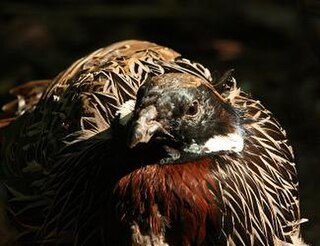 W
WAn argus, or argus pheasant, is a member of the subtribe Argusianina in the tribe Pavonini of the family Phasianidae, containing two species of bird that are closely related to peafowl. It has hundreds or thousands of tiny white spots on its plumage pattern, and thus its naming might have been in reference to the mythical hundred-eyed giant, Argus Panoptes.
 W
WThe blood pheasant, also known as blood partridge, is the only species in genus Ithaginis and tribe Ithaginini of the pheasant family. It is a relatively small, short-tailed pheasant that is widespread and is fairly common in eastern Himalayas, ranging across India, Nepal, Bhutan, China, and northern Myanmar. Since the trend of the population appears to be slowly decreasing, the species has been evaluated as of least concern by IUCN in 2009.
 W
WThe cheer pheasant, also known as Wallich's pheasant or chir pheasant, is a vulnerable species of the pheasant family, Phasianidae. It is the only member in the genus Catreus. The scientific name commemorates Danish botanist Nathaniel Wallich.
 W
WThe great argus is a species of pheasant from Southeast Asia.
 W
WThe koklass pheasant is a species of gamebird, being closely related to progenitive grouse that lived during the Miocene. They are distantly related to pheasants and are most closely related to grouse and turkeys. Koklass are the only species in the monotypic genus Pucrasia and the tribe Pucrasiini. Both the words koklass and pucrasia have been onomatopœically derived from the bird's territorial call. Koklass are boreal adapted species which separate into three distinct species groups. They are one of the few gamebirds that regularly fly uphill and are capable of sustained flights of many miles. They are monogamous with a slight tendency toward social polyandry. Both parents rear the chicks. Koklass are largely vegetarian for much of the year consuming pine nuts, pine shoots, bamboo shoots and seeds. They are highly insectivorous during the warmer months that coincide with nesting and chick-rearing. During this phase of their life cycle they live almost exclusively on ants but also are documented consuming catkins, pollen and fruit.
 W
WPheasant shooting is the activity of shooting the common pheasant. It takes place in the United Kingdom, and is practised in other parts of the world. Shooting of game birds is carried out using a shotgun, often 12 and 20 bore or a .410, sometimes on land managed by a gamekeeper.
 W
WA pheasantry is a place or facility used for captive breeding and rearing pheasants, peafowls and other related birds, which may or may not be confined with enclosures such as aviaries. The pheasants may be sold or displayed to public or used as game birds. Pheasantry may also be used for conservation and research purposes.